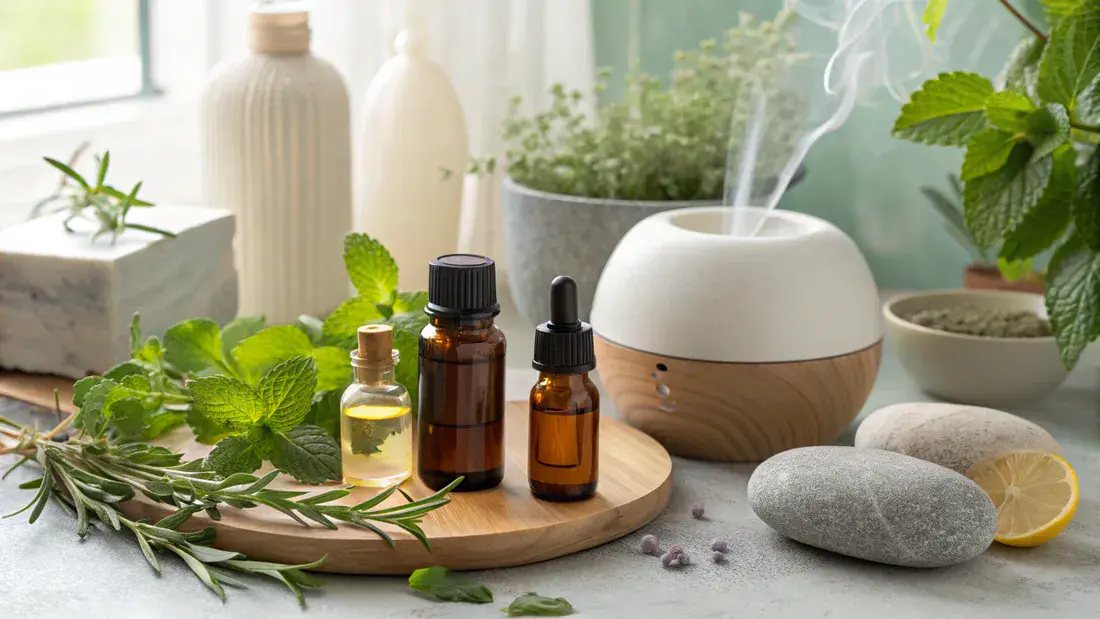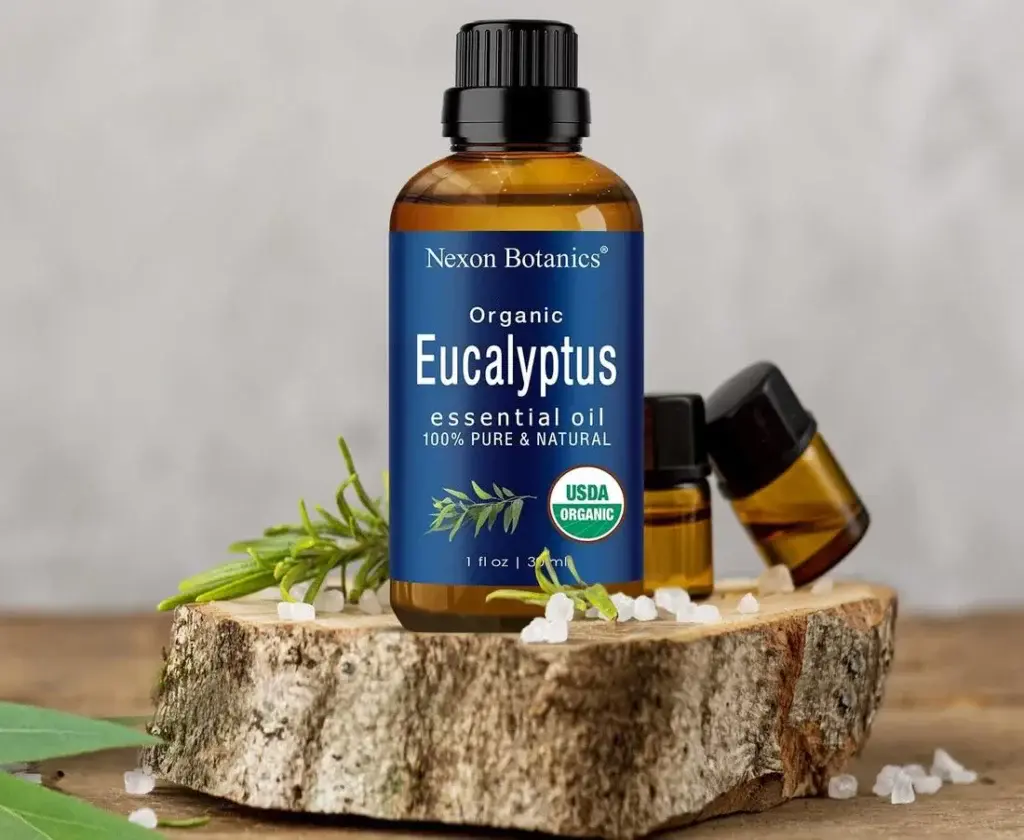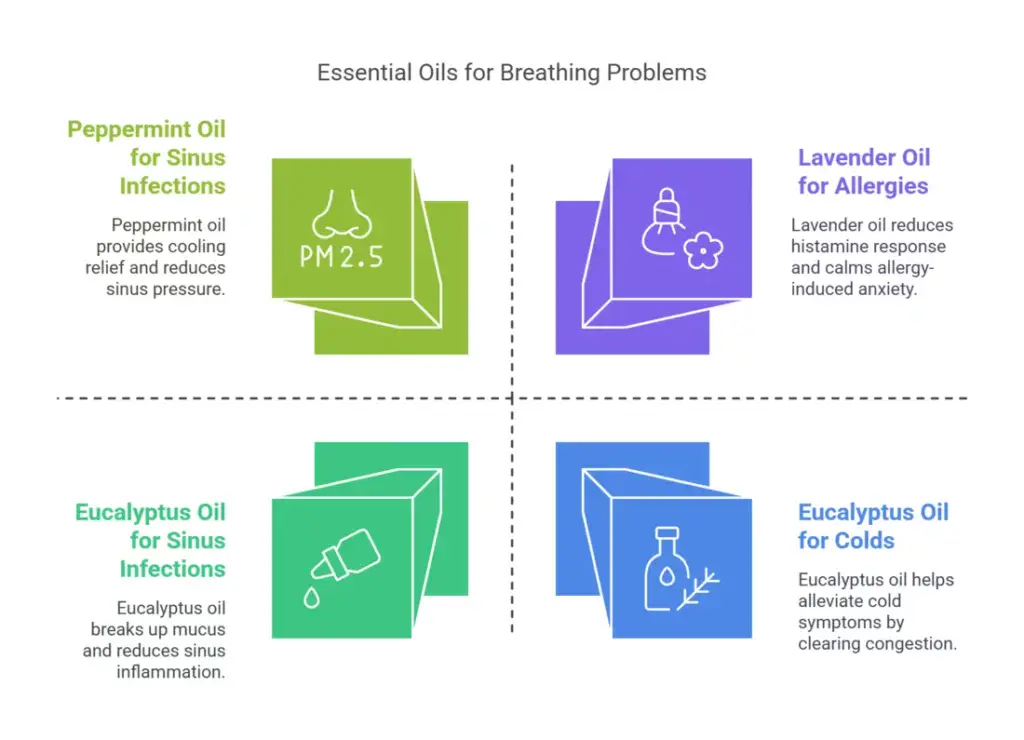In a world filled with pollutants, allergens, and seasonal challenges, the simple act of breathing can sometimes become surprisingly difficult.

Whether you’re battling congestion from a stubborn cold, struggling with seasonal allergies, or simply seeking clearer airways, natural solutions like essential oils offer powerful support for respiratory health.
This comprehensive guide delves into the science-backed benefits of essential oils for breathing support, providing you with practical, actionable advice you won’t find anywhere else.
We’ve analyzed hundreds of scientific studies and gathered insights from respiratory specialists to bring you the most effective natural approaches to breathing better.
Understanding Breathing Difficulties – Common Causes and Symptoms
Before exploring solutions, it’s important to understand what might be causing your breathing difficulties. Several common culprits include:
Allergies: Pollen, dust mites, pet dander, and mold can trigger allergic reactions that lead to nasal congestion and breathing issues.
Colds and Flu: Viral infections often lead to inflammation of the nasal passages and excess mucus production.
Sinus Infections: Bacterial or viral infections in the sinuses can cause painful pressure and significant breathing obstruction.
Asthma: This chronic condition involves inflammation and narrowing of the airways, making breathing difficult, especially during flare-ups.
Environmental Irritants: Smoke, pollution, strong perfumes, and cleaning products can irritate sensitive airways.
Common symptoms of breathing difficulties include:
- Congestion and stuffy nose
- Excessive mucus production
- Persistent coughing
- Shortness of breath
- Wheezing or whistling sounds when breathing
- Sinus pressure and headaches
Important Note: While essential oils can provide significant relief for many breathing issues, they are not a replacement for medical treatment. If you experience severe or persistent breathing problems, please consult a healthcare professional immediately.
What are the Best Essential Oils for Breathing? (Backed by Science)
Not all essential oils are created equal when it comes to respiratory support.
Let’s examine the most effective options supported by scientific research.
Eucalyptus Oil – The Congestion Buster

Eucalyptus oil stands as perhaps the most powerful essential oil for respiratory support, and for good reason.
Its active component, 1,8-cineole (eucalyptol), has been extensively studied for its effects on the respiratory system.
Research shows that eucalyptol works effectively by:
- Breaking down mucus and phlegm
- Reducing inflammation in the airways
- Providing a cooling, opening sensation that makes breathing feel easier
- Fighting respiratory pathogens with its antimicrobial properties
Eucalyptus oil is most effective when used in:
- Steam inhalation for direct delivery to inflamed airways
- Diffuser blends for ambient relief
- Diluted chest rubs (always mix with a carrier oil like coconut or jojoba)
Peppermint Oil – The Inflammation Fighter
Peppermint oil’s primary active component, menthol, provides that unmistakable cooling sensation that can make breathing feel instantaneously easier.
Beyond just sensation, however, research shows peppermint oil offers substantial benefits:
- Menthol acts as a natural decongestant by helping dissolve mucus
- It has anti-inflammatory properties that can reduce swelling in nasal passages
- The cooling effect provides psychological relief that can reduce the anxiety associated with difficult breathing
- Its antimicrobial properties may help fight respiratory infections
Safety Note: Peppermint oil is not recommended for use around infants or young children under age 6, as the menthol can potentially cause breathing problems in very young children. Never apply it directly near their face or chest.
Lavender Oil – The Calming Breath Aid
While lavender may not be the first oil you think of for breathing support, its benefits for respiratory health come through a different mechanism: stress reduction.
Stress and anxiety can significantly impact breathing patterns, leading to shallow breathing and increased perception of breathing difficulties.
Lavender oil has been clinically proven to:
- Reduce anxiety levels, which can help normalize breathing patterns
- Promote deeper, more restful sleep, which is essential for respiratory recovery
- Provide mild anti-inflammatory effects that can help with respiratory comfort
Lavender is exceptionally versatile and can be used in:
- Bedtime diffuser blends to promote better breathing during sleep
- Bath blends for relaxation and respiratory support
- Diluted topical applications for a calming effect
Other Beneficial Essential Oils
Tea Tree Oil: Known primarily for its powerful antimicrobial properties, tea tree oil can help fight respiratory infections that cause breathing difficulties.
Research has shown that tea tree oil components can reduce the inflammatory response in the airways.
Rosemary Oil: Contains compounds like 1,8-cineole (similar to eucalyptus) and camphene that act as expectorants, helping to clear mucus from the airways.
Rosemary oil has antispasmodic effects that may help relax the smooth muscles of the bronchial passages.
Lemon Oil: Rich in d-limonene, lemon oil supports the immune system while providing a refreshing scent that can make breathing feel clearer.
Its antimicrobial properties can help fight respiratory pathogens, while its bright scent can help overcome the feeling of congestion.
Essential Oils for Specific Breathing Problems

Different breathing issues may respond better to certain oils or combinations.
Here’s a targeted approach based on your specific condition:
Essential Oils for Allergies
Allergic responses typically involve inflammation, excess mucus production, and uncomfortable symptoms like sneezing and itchy eyes.
The most effective oils for allergy relief include:
Lavender Oil: Helps reduce the body’s histamine response while calming allergy-related anxiety.
Chamomile Oil: Offers natural antihistamine properties that can reduce allergic reactions.
Eucalyptus Oil: Clears congestion and opens airways constricted by allergic responses.
Many allergy sufferers report success with this diffuser blend:
- 3 drops lavender oil
- 2 drops chamomile oil
- 2 drops eucalyptus oil
- 1 drop lemon oil
For nighttime allergy relief, try a diluted bedside application of lavender and chamomile in equal parts with a carrier oil.
Essential Oils for Sinus Infections
Sinus infections create painful pressure and significant breathing obstruction.
These oils offer the most targeted relief:
Eucalyptus Oil: Helps break up mucus and reduce sinus inflammation.
Tea Tree Oil: Fights the underlying bacterial or fungal infection causing sinus issues.
Peppermint Oil: Provides immediate cooling sensation that can help reduce the perception of sinus pressure.
For effective sinus relief, try this steam inhalation:
- Add 3-4 drops of eucalyptus and 2 drops of tea tree oil to a bowl of hot water
- Place a towel over your head and the bowl
- Breathe deeply for 5-10 minutes
Important Safety Note: Never introduce essential oils directly into the nasal passages or sinuses, as this can cause serious irritation or damage.
Essential Oils for Colds and Flu
When battling a respiratory infection, these oils offer powerful support:
Eucalyptus Oil: Breaks up chest and nasal congestion while fighting respiratory pathogens.
Peppermint Oil: Helps reduce fever and provides cooling relief for inflamed passages.
Rosemary Oil: Acts as an expectorant to clear mucus while supporting the immune system.
Lemon Oil: Provides immune support and energy during illness.
Try this immune-boosting diffuser blend:
- 3 drops eucalyptus oil
- 2 drops lemon oil
- 2 drops tea tree oil
- 1 drop rosemary oil
For nighttime relief, a diluted chest rub containing eucalyptus and a small amount of peppermint can promote easier breathing while sleeping.
Essential Oils for Asthma Relief – What the Science Says
Understanding Asthma and Essential Oils
Asthma requires special consideration when it comes to essential oils.
This chronic respiratory condition involves inflammation and narrowing of the airways, and certain strong scents can potentially trigger asthma symptoms in some individuals.
Critical Note: Essential oils should NEVER be used as a replacement for prescribed asthma medication. Your inhaler and other prescribed treatments are essential for managing this serious condition.
Research on Breathe Essential Oils for Asthma
The scientific research on essential oils for asthma is still developing, with mixed results.
Some studies show promise regarding compounds in essential oils like eucalyptol that may have bronchodilatory effects.
Other research suggests that lavender oil may help reduce inflammation in the airways, potentially supporting easier breathing.
However, the research has significant limitations.
Most studies have been conducted in laboratory settings or animal models, with few large-scale human clinical trials specifically focused on asthma and essential oils.
How to Use Breathe Essential Oil for Asthma Safely (If Approved by Your Doctor)
If you’re interested in exploring essential oils as a complementary approach to managing asthma (alongside your prescribed medication), follow these guidelines:
- Consult your doctor first: Get explicit approval from your healthcare provider before trying any essential oils.
- Start with gentle oils: Lavender is generally considered one of the safest oils and is less likely to trigger respiratory sensitivity.
- Use ambient methods first: Begin with very minimal amounts in a diffuser placed at a distance, rather than direct inhalation or topical application.
- Monitor closely: Pay careful attention to how your breathing responds, and discontinue use immediately if you notice any worsening of symptoms.
- Avoid direct application: Never apply essential oils directly to the chest or throat area if you have asthma without specific guidance from a healthcare provider.
- Keep rescue medication on hand: Always have your rescue inhaler immediately available when trying any new essential oil.
How to Use Essential Oils for Breathing Better
Diffuser Blends for Respiratory Support

Diffusion is one of the safest and most effective ways to use essential oils for breathing support.
Here are some specialized blends for different needs:
Clear Airways Blend:
- 4 drops eucalyptus oil
- 3 drops peppermint oil
- 2 drops rosemary oil
Allergy Relief Blend:
- 3 drops lavender oil
- 3 drops lemon oil
- 2 drops peppermint oil
Nighttime Breathing Blend:
- 4 drops lavender oil
- 3 drops eucalyptus oil
- 2 drops chamomile oil
Immune Support Breathing Blend:
- 3 drops tea tree oil
- 3 drops lemon oil
- 2 drops eucalyptus oil
- 1 drop cinnamon oil
For optimal results, run your diffuser for 30-60 minutes in your bedroom before sleep, or in your main living area during the day.
Avoid continuous diffusion, as this can sometimes irritate sensitive airways.
Steam Inhalation for Congestion Relief

Steam inhalation delivers essential oils directly to irritated airways for immediate relief.
Here’s how to do it safely:
- Boil 1-2 cups of water and pour into a heat-safe bowl
- Add 3-5 drops of essential oil (eucalyptus, peppermint, or tea tree work best)
- Place a towel over your head and the bowl, creating a tent
- Close your eyes and breathe deeply through your nose for 5-10 minutes
- Take breaks if the steam feels too intense
Best oils for steam inhalation:
- Eucalyptus: Best for heavy congestion
- Peppermint: Excellent for sinus pressure
- Tea Tree: Ideal when fighting an infection
- Thyme: Powerful for chest congestion
Safety note: Keep eyes closed during steam inhalation to prevent eye irritation, and ensure the water isn’t too hot to avoid burns from steam.
Topical Application for Soothing Airways
When applied properly, topical essential oil blends can provide hours of breathing relief.
Always follow these guidelines:
- Never apply essential oils undiluted to the skin
- Use appropriate dilution ratios:
- For adults: 2-3% dilution (12-18 drops of essential oil per ounce of carrier oil)
- For children over 6: 1% dilution (6 drops per ounce of carrier oil)
- For elderly or those with sensitive skin: 1% dilution
Respiratory Relief Chest Rub:
- 2 tablespoons coconut oil (solid at room temperature)
- 10 drops eucalyptus oil
- 6 drops peppermint oil
- 4 drops rosemary oil
Melt the coconut oil gently, mix in essential oils thoroughly, and allow to solidify.
Apply to chest, upper back, and throat as needed for breathing relief.
Bedtime Breathing Balm:
- 2 tablespoons shea butter
- 1 tablespoon jojoba oil
- 8 drops lavender oil
- 6 drops eucalyptus oil
- 4 drops chamomile oil
Melt shea butter gently, add jojoba and essential oils, and pour into a small container to solidify.
Apply to chest and upper back before bedtime.
Safety Precautions When Using Essential Oils for Breathing

Essential oils are powerful plant compounds that require proper handling.
Follow these safety guidelines:
- Always dilute properly: Never apply essential oils directly to the skin without a carrier oil.
- Perform patch tests: Before using a new oil, apply a small diluted amount to your inner arm and wait 24 hours to check for reactions.
- Use caution with children:
- Never use peppermint or eucalyptus oils on or near the faces of infants or children under 6
- Use only very diluted, gentle oils like lavender for children 6-12
- Keep all essential oils out of reach of children
- Respiratory considerations:
- If you have asthma or COPD, consult a doctor before using any essential oils
- Start with brief exposure to highly diluted oils
- Discontinue immediately if breathing becomes more difficult
- Pregnancy and nursing:
- Many oils are not recommended during pregnancy, especially in the first trimester
- Consult with a healthcare provider before using any essential oils while pregnant or nursing
- Ingestion safety:
- Never ingest essential oils for breathing relief
- Keep oils away from the eyes, inside of nose, and other sensitive mucous membranes
- Storage guidelines:
- Store oils in dark glass bottles away from direct sunlight
- Keep bottles tightly closed and out of reach of children and pets
- Label all diluted blends clearly with contents and dates
Frequently Asked Questions (FAQs)
What are the best essential oils for a stuffy nose?
For immediate stuffy nose relief, eucalyptus and peppermint oils are most effective.
Eucalyptus helps break up mucus, while peppermint’s menthol provides an immediate sensation of clearer breathing.
For children over 6, a very diluted eucalyptus in a diffuser placed across the room can help.
For children under 6, consider gentle lavender instead.
Can essential oils help with bronchitis?
While essential oils may help manage some symptoms of bronchitis, they should be used as a complement to proper medical treatment, not a replacement.
Eucalyptus and tea tree oils in a steam inhalation may help loosen mucus, while oils like thyme and oregano have antimicrobial properties that might support recovery.
Always consult your doctor if you suspect bronchitis, as it can develop into a serious condition requiring antibiotics or other medical interventions.
Are essential oils safe to use around pets?
Many essential oils that help with breathing—particularly tea tree, eucalyptus, and peppermint—can be toxic to pets, especially cats.
Never apply these oils to your pets, and use caution when diffusing.
Ensure pets can leave the room where oils are being diffused, provide good ventilation, and use minimal amounts.
Certain oils should never be used around cats, including tea tree, citrus oils, peppermint, cinnamon, and eucalyptus.
How do I choose a good quality essential oil?
Quality matters tremendously when selecting essential oils for therapeutic use.
Look for:
- Purity: The label should indicate “100% pure essential oil” with no additives or synthetics
- Botanical name: The Latin name of the plant should be clearly listed
- Sourcing transparency: Reputable companies disclose where their plants are grown
- Testing verification: Look for companies that provide GC/MS (Gas Chromatography/Mass Spectrometry) test results
- Appropriate packaging: Oils should come in dark glass bottles to protect them from light damage
- Reasonable pricing: Extremely cheap oils are likely adulterated or synthetic
What’s the best diffuser for essential oils?
The most effective diffuser for respiratory support is an ultrasonic diffuser, which uses water to create a fine mist of essential oil particles that remain airborne for longer periods.
Look for:
- Run time of 4+ hours for overnight breathing support
- Auto-shutoff feature for safety
- Coverage area appropriate for your room size (usually measured in square feet)
- Low noise operation for bedroom use
- BPA-free plastic components
Nebulizing diffusers, which use only the essential oil without water, provide the most potent aromatherapy but may be too strong for those with sensitive airways or respiratory conditions.
Can essential oils help with long covid breathing problems?
Some individuals experiencing lingering breathing difficulties after COVID-19 report finding relief with gentle essential oil protocols.
The most commonly reported helpful oils include eucalyptus for opening airways, lavender for reducing anxiety associated with breathing difficulties, and rosemary for mental clarity and respiratory support.
However, it’s crucial to:
- Work directly with your healthcare provider to develop an appropriate plan
- Start with extremely diluted applications
- Discontinue immediately if symptoms worsen
- Consider using oils primarily for the anxiety component of post-COVID breathing issues rather than as a direct respiratory treatment
Research in this area is still emerging, so approach with caution and medical supervision.
Conclusion
Essential oils offer powerful, natural support for respiratory health when used correctly and safely.
From the powerful decongestant properties of eucalyptus to the calming effects of lavender that help normalize breathing patterns during stress, these plant-based solutions can significantly improve your breathing experience.
Remember that while essential oils can provide remarkable relief, they work best as part of a holistic approach to respiratory health that includes proper hydration, clean air, appropriate medical care, and healthy lifestyle choices.
Start with small amounts of high-quality oils, follow dilution guidelines carefully, and pay attention to how your body responds.
With proper use, essential oils may become one of your most valued tools for maintaining open, comfortable airways throughout the changing seasons.
Ready to breathe easier?
Try one of our recommended diffuser blends tonight and experience the difference that therapeutic-grade essential oils can make for your respiratory comfort.
References
- Juergens, U.R., et al. (2003). Anti-inflammatory activity of 1.8-cineol (eucalyptol) in bronchial asthma: a double-blind placebo-controlled trial. Respiratory Medicine, 97(3), 250-256.
- Sadlon, A.E., & Lamson, D.W. (2010). Immune-modifying and antimicrobial effects of Eucalyptus oil and simple inhalation devices. Alternative Medicine Review, 15(1), 33-47.
- McKay, D.L., & Blumberg, J.B. (2006). A review of the bioactivity and potential health benefits of peppermint tea (Mentha piperita L.). Phytotherapy Research, 20(8), 619-633.
- Göbel, H., et al. (1994). Effect of peppermint and eucalyptus oil preparations on neurophysiological and experimental algesimetric headache parameters. Cephalalgia, 14(3), 228-234.
- Cavanagh, H.M., & Wilkinson, J.M. (2002). Biological activities of lavender essential oil. Phytotherapy Research, 16(4), 301-308.
- Carson, C.F., et al. (2006). Melaleuca alternifolia (Tea Tree) oil: a review of antimicrobial and other medicinal properties. Clinical Microbiology Reviews, 19(1), 50-62.
- Moss, M., et al. (2003). Aromas of rosemary and lavender essential oils differentially affect cognition and mood in healthy adults. International Journal of Neuroscience, 113(1), 15-38.
- Komiya, M., et al. (2006). Lemon oil vapor causes an anti-stress effect via modulating the 5-HT and DA activities in mice. Behavioural Brain Research, 172(2), 240-249.
- Horváth, G., & Ács, K. (2015). Essential oils in the treatment of respiratory tract diseases highlighting their role in bacterial infections and their anti-inflammatory action: a review. Flavour and Fragrance Journal, 30(5), 331-341.
- Woolf, A. (1999). Essential oil poisoning. Journal of Toxicology: Clinical Toxicology, 37(6), 721-727.
- Takarada, K., et al. (2004). A comparison of the antibacterial efficacies of essential oils against oral pathogens. Oral Microbiology and Immunology, 19(1), 61-64.
- Worth, H., et al. (2009). Concomitant therapy with Cineole (Eucalyptole) reduces exacerbations in COPD: A placebo-controlled double-blind trial. Respiratory Research, 10(1), 69.
- Fisher, K., & Phillips, C. (2008). Potential antimicrobial uses of essential oils in food: is citrus the answer? Trends in Food Science & Technology, 19(3), 156-164.
- Warnke, P.H., et al. (2009). The battle against multi-resistant strains: Renaissance of antimicrobial essential oils as a promising force to fight hospital-acquired infections. Journal of Cranio-Maxillofacial Surgery, 37(7), 392-397.
This article is for informational purposes only and does not constitute medical advice. Always consult with a qualified healthcare provider before beginning any new health regimen, including the use of essential oils.
Related Posts
No posts
